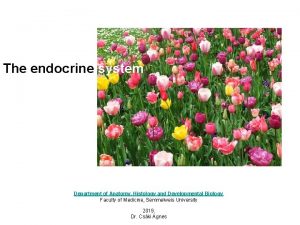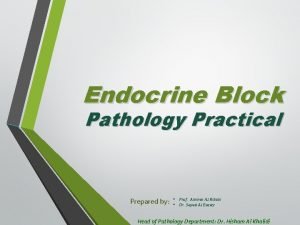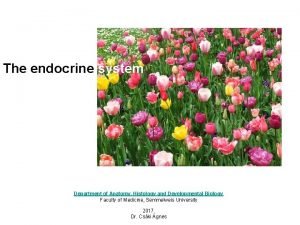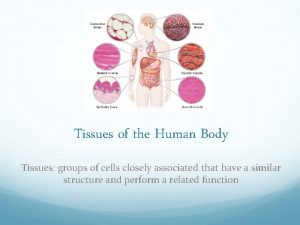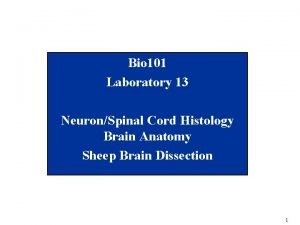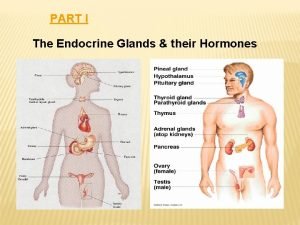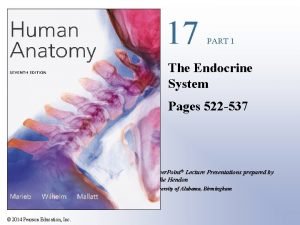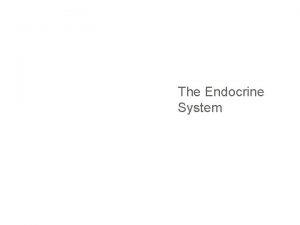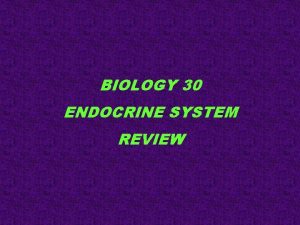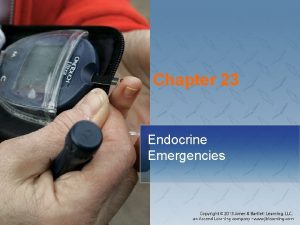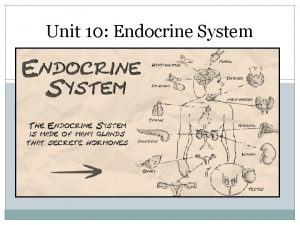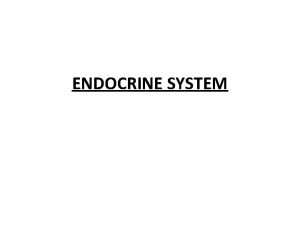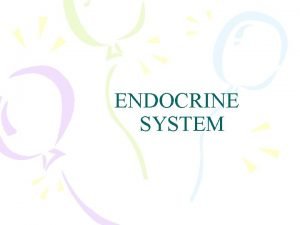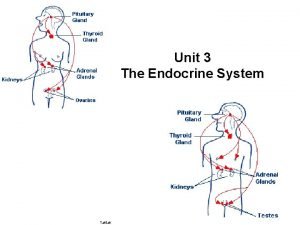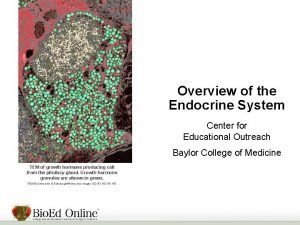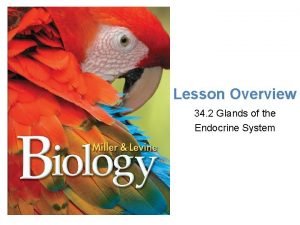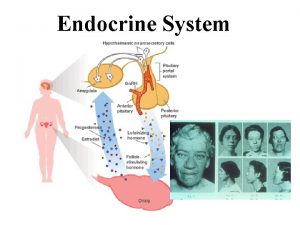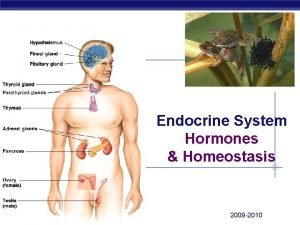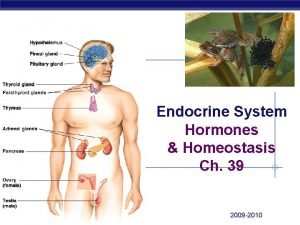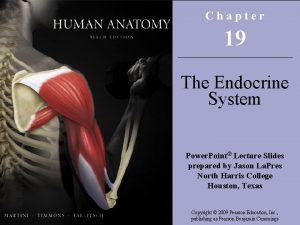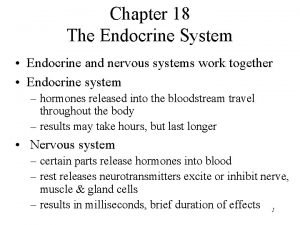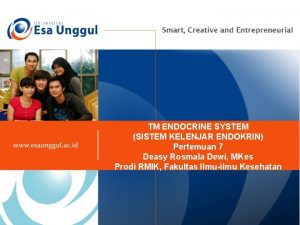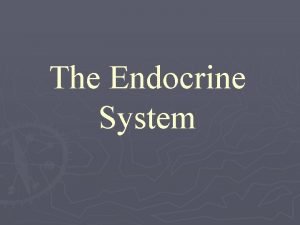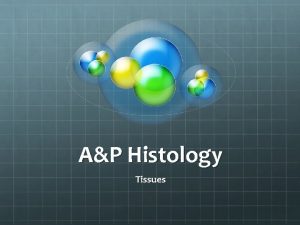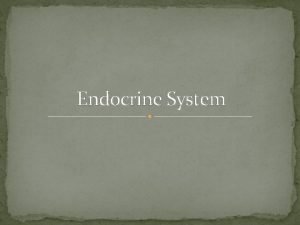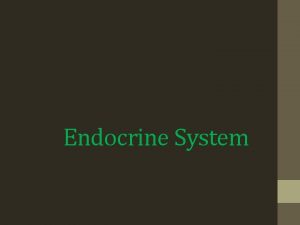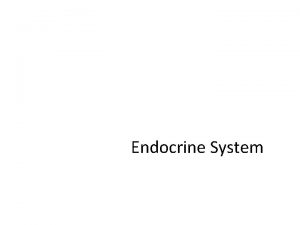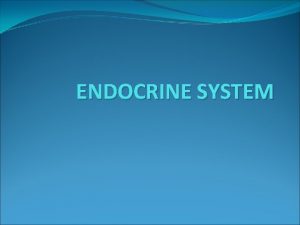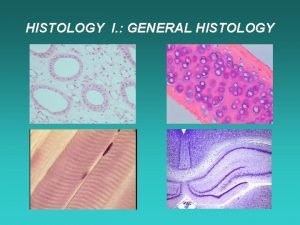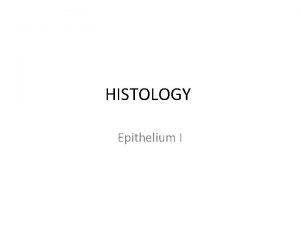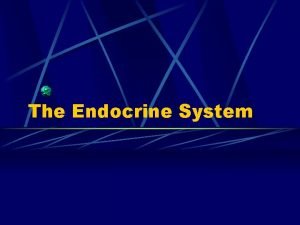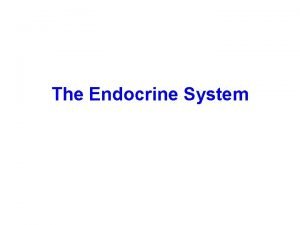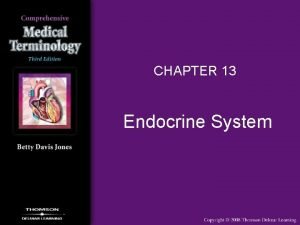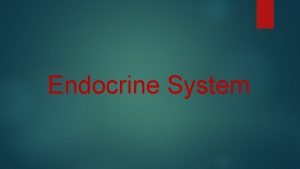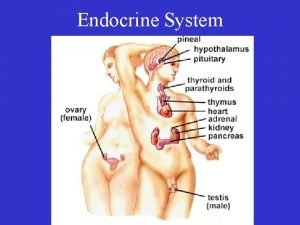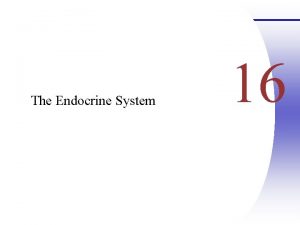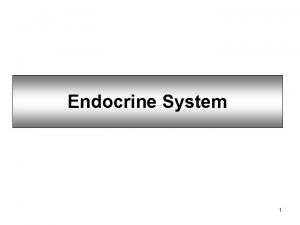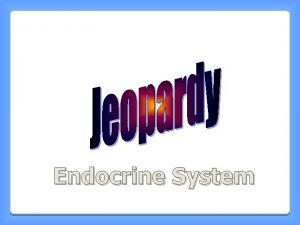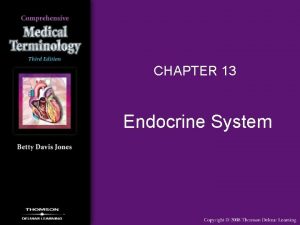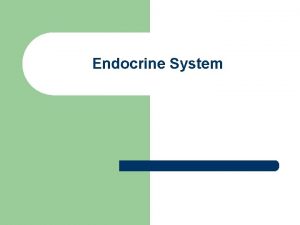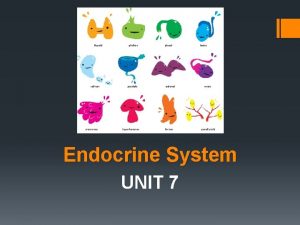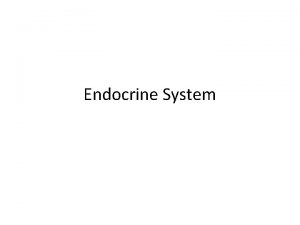The endocrine system Department of Anatomy Histology and
















































- Slides: 48

The endocrine system Department of Anatomy, Histology and Developmental Biology Faculty of Medicine, Semmelweis University 2019. Dr. Csáki Ágnes

The glands of the endocrine system secrete hormones into the bloodstream to maintain homeostasis and regulate metabolism. Hormone: -minute amount of chemical substances (amines, steroids, peptides, proteins ) coordinate metabolic processes in cells and organs by activating enzymes (although each hormone is distributed by the blood , only particular cells with a specific receptor for it react to each individual hormone) (membrane or cytoplasmic receptors) -hormones are also produced by neurons of CNS and PNS: neurohormones -are vital substances [hyper or hyposecretion of a hormone leads to typical disease patterns]

MECHANISM OF SIGNAL TRANSMISSION cell endocrine neuron capillary neurohormon parakrin cell autokrin

Tissues and individual cells secreting hormons Classic endocrine organs Central and autonomic nervous System Parts of the diencephalon (e. g. , hypothalamus) System of gastrointestinal cells Atria of the heart Atrial natriuretic peptide Kidneys Liver Immune organs (thymus) C cells Tissue hormones Ovary placenta

Types of glands exocrine endocrine

Regulation of Hormone Secretion The hypothalamus and the pituitary gland are the command control centers, directing hormones to other glands and throughout the body The stability of the blood level of a hormone is the result of a complicated regulating mechanism: „feedback„ mechanism: It is a process in which the level of one substance influences the level of another substance. A mechanism or a signal that tends to initiate (or accelerate) or to inhibit (or slow down) a process. hormon level falls - more of it is released if it rises - less hormone is Negative feedback: produced

FEED-BACK MECHANISM ultrashort feedback (neural) hypophyseotroph neurons Other brain areas (limbic system, sensory organs. . ) Hyper or hyposecretion of a hormone leads to typical disease patterns hypothalamus ultrashort feedback (humoral) hypophysis anterior lobe troph hormones short feedback long feedback Béla Halász, in: Handbook of Clinical Endocrinology and Metabolic Diseases glands cells

The hypothalamus and the pituitary gland are part of the diencephalon region of the brain. The hypothalamus connects the nervous system to the endocrine system. It receives and processes signals from other brain regions and translates them into hormones. These hormones flow to the pituitary gland, which is connected to the hypothalamus Some hypothalamic hormones are stored in the pituitary for later release; others spur it to secrete its own hormones. Master of endocrine glands: Hypothalamus („real boss”) and Hypophysis („master gland”)

FUNCTIONS OF THE HYPOTHALAMUS Regulates the hypophysis Serves as an endocrine organ: oxytocyn, vasopressin secretion Other functions: Integrator and modulator of autonomic activity (by zones and regions) - sympathetic and parasympathetic centers (stress) - control the body temperature - regulation of food and water intake etc. Circadian rythm through biological clock (jet leg) Sexual behavior and reproduction

MEDIAN SAGITTAL SECTION OF THE BRAIN HYPOTHALAMUS Position of hypothalamus CEREBRAL HEMISPHERE THALAMUS EM ST M U N AI L EL BR EB ER C III. v. STALK- pituitary gland / hypophysis

HYPOTHALAMUS INFERIOR VIEW Visual system: optic chiasm hypophyseal stalk optic tract Hypophyseal tumors!! These benign tumors do not spread outside the skull. They usually remain confined to the sella turcica (the tiny space in the skull that the pituitary gland sits in). There is very little room for tumors to grow in this part of the skull. Therefore, if the tumor becomes larger than about a centimeter (about half an inch) across, it may grow upward, where it can compress and damage nearby parts of the brain and the nerves that arise from it. This can lead to symptoms such as vision changes or headaches.


Median sagittal MRI section with the hypophysis hypothalamus Air-filled sphenoidalis sinus (sphenoid bone) nasal cavity tongue cerebellum brain stem

SELLA TURCICA pituitary gland Operation of the hypophysis through the nasal cavity and sphenoidal sinus X-ray film

Hypophysis, pituitary gland Known as the "Master Gland", this part of the brain consists of two parts called adeno hypophysis and neurohypophysis. hypothalamus pituitary stalk Optic chiasm 1. Neurohypophysis (posterior part) Nervous tissue 2. Adenohypophysis (Anterior and intermediate part) Only storage of hormones produced by hypothalamus Glandular tissue Producing of hormones sella turcica / fossa hypophysealis/ bone

Two groups of the cells in the hypothalamus: magnocellular and parvocellular nuclei, act on different parts of the hypophysis

„magnocellular” nuclei (groups of big neurons): secretion of oxytocyn and antidiuretic hormon (ADH) /vasopressin / axonal transport to the hypophysis and stored in the posterior lobe and released to the capillaries

FUNCTION OF POSTERIOR PITUITARY HORMONES OXYTOCIN Contraction of uterinal smooth muscle (delivery) Contraction of the mammary gland smooth muscle (milk ejection) VASOPRESSIN (antidiuretic hormone) Vasoconstrictor, enhances the blood pressure Water absorption in the collective tubules of kidney


„parvocellular”nuclei (groups of small neurons ) Releasing or inhibiting hormones Parvocellular PORTAL CIRCULATION OF RELEASING HORMONES (factors) LHRH (luteinizing hormone-releasing hormone) TRH (thyreotrop hormone-releasing hormone) CRH (corticotrop hormone-releasing hormone) GRH (growth hormone-releasing hormone) INHIBITING HORMONES (factors) THE ANTERIOR PITUITARY Somatostatin (growth hormone-inhibiting hormone Dopamine (prolactin-inhibiting hormone) pituitary stalk portal vessels Hormones of the adenohypophysis : LH: luteinizing hormone FSH: follicle stimulating hormon ACTH: adrenocorticotropin h TSH: thyroid stimulating h GH: somatotrpic h MSH: melanocyte stimulating h PRL: prolactin (mammotropic) anterior pituitary (adenohypophysis- gland) Béla Halász, in: Handbook of Clinical Endocrinology and Metabolic Diseases

Hystology of the hypophysis Posterior lobe : NEUROHYPOPHYSIS Axons, glial cells and capillaries Anterior and intermediate lobe: Real gland ADENOHYPOPHYSIS Chromophil cells: well stained Basophil and acidophil cells produce hormones Chromophob cells poorly stained unknown function Capillaries, sinusoids

HORMONES OF THE ANTERIOR LOBE GH (growth hormone) LH (luteinizing hormone) - acidophil cells FSH (follicle stimulating hormone) TSH (thyroid stimulating hormone) ACTH (adrenocorticotrop hormone) LTH (luteotrop hormone, prolactin) - basophil cells Interleukins, growth factors (folliculostellate cells)

(Anterior lobe) Growth hormon (GH) Acidophil Cell growth hormon induces growth throught insuline like factor produced by hepatocytes. IGF-1 stimulates the growth of long bones by stimulating the hypertrophy of epiphyseal plates

• Inadequate production of somatotropin (GH) maybe • Hypo- or Hyperproduction Hypo: Pituitary dwarfism normal size dwarf (neat, proportional)

Hyperproduction of somatostatin (GH) GIGANTISM ACROMEGALY in adults, after full growth has ceased (Ill-proportioned, normal giant normal high level from childhood Enlargement of the bones in the jaws and in the front of the skull are typically the most apparent bony changes. Acromegaly may also cause thickening of the soft tissues of the body, including the heart, lips, and tongue.

(Anterior lobe) Prolactin Acidophil cells

(Anterior lobe) FSH(folliculus stimulating hormon) LH (luteinizing hormon) Basophil cells Stimulates development of Graafin follicles (= a mature follicle in the ovary prior to ovulation) Brings about ovulation and maintains the corpus luteum.

(Anterior lobe) TSH (thyroid stimulating hormon) Basophil cells Stimulates the thyroid to release T 3 and T 4.

(Anterior lobe) ACTH Basophil cell Stimulates the adrenal cortex to produce: Corticosteriods: mineral corticoids glucocorticoids cortisol (natural anti-inflammatory !) androgens, e. g. aldosterone

Central endocrine organ: pituitary gland, hypothalamus Peripheral endocrine organs 1. Pituitary-dependent endocrine organs Thyroid gland Adrenal gland (Ovary or testis) 2. Pituitary-independent endocrine organs and cells Pineal body Parathyroid gland Islets of Langerhans (Placenta) (Enteroendocrine cells – cells in the gastrointestinal tract)

1. Pituitary-dependent endocrine organs Thyroid gland At the trachea (in its capsule there are four parathyroid glands !) Hypothalamic TRH Hypophyseal TSH Trijodthyronin(T 3), thyroxin(T 4) (C cells produce calcitonin - independent)

Histology of the thyroid gland colloid in follicles T 4, T 3 hematoxylin-eosin staining immunostaining for calcitonin in C-cells Calcitonin lowers the calcium level of the blood and promotes bone formation

Mechanism of Thyroid hormone production SYNTHESIS absorption by endocytosis colloid follicular epithelium lysosome colloid (thyroglobulin) RER Functional phases of the follicular cells: -secretion is being formed -during storage -during the phase of secretion iodine amino acids + iodine Thyroxin (T 4) Triiodothyronin (T 3) capillary

Hypo- and hyperfunction of the gland: BASEDOW-DISEASE (hyperthyreosis) CRETENISM (hypothyreosis from childhood) Mentally retarded It is particularly important for children and babies to have enough thyroid hormones (jodine!!!), because a lack of these hormones at an early stage of life can have severe effects on physical and emotional development bigger and become visible as a “goiter”, also called “struma. ”

Adrenal gland cortex Adrenal gland medulla kidney Section of the gland vein cortex medulla

Adrenal gland 3 layers of the cortex zona glomerulosa zona fasciculata cortex zona reticularis medulla

Zona reticularis Zona glomerulosa Zona fasciculata Glükocorticoids-cortisol sexual steroids mineralocorticoids MEDULLA: neuronal cells produce EPINEPHRIN, NOREPINEPHRIN sympathetic system!! involved in defense reaction to stress (hypothalamic-pituitary-adrenal (HPA) axis)

Cushing's syndrome is a collection of signs and symptoms due to prolonged exposure to cortisol. Signs and symptoms may include: high blood pressure, abdominal obesity but with thin arms and legs, reddish stretch marks, a round red face, a fat hump between the shoulders, weak muscles, weak bones, acne, and fragile skin that heals poorly. Women may have more hair and irregular menstruation. Cushing syndroma Overproduction of zona fasciculata Occasionally there may be changes in mood, headaches, and a chronic feeling of tiredness.

2. Pituitary-independent endocrine organs PINEAL BODY or epiphysis HISTOLOGY Part of the thalamus brain sand calcified structures Pinealocytes Glial cells capillaries Melatonin: produced from serotonin, restricts the release of gonadotropins, restrains development of gonads, subfunctional pineal body –pubertas precox: early sexual maturation Regulates the day and night rythm,

Parathyroid glands Chief cells Oxyphil cell: unknown function Fat cell (Thyroid gland) Chief cells produce parathormone: controls the concentration of calcium and phosphate ions of blood: elevates the blood Ca level: antagonist of the Calcitonin!!

In the pancreas – Langerhans islets spleen kidney duodenum Inferior vena cava aorta

Exocrine and endocrine

LANGERHANS-islets in the pancreas (about 1 million) A-cells: GLUCAGON B-cells: INSULIN regulate glucose levels in the blood D-cells: SOMATOSTATIN P-cells: PANCREAS-POLYPEPTID Exocrin pancreas Tripsine Kimotriipsine Carboxypeptidase Pancreas ami amilase Pancreas lipase DNA-se, RNA-se

Thank for your attention! Szentágothai János, Réthelyi Miklós: Funkcionális anatómia Kiss Ferenc, Szentágothai János: Az ember anatómiájának atlasza Johannes W. Rohen, Chihiro Yokochi, Elke Lütjen-Drecoll: Color atlas of anatomy Röhlich Pál: Szövettan Leövey János: Handbook of clinical endocrinology and metabolic diseases

T 3 and T 4 increase the basal metabolic rate. All body cells then work harder and therefore need more energy. This means: Body temperature rises The heart beat becomes stronger and the pulse faster Food is used up more quickly because energy stored in the liver and muscles is broken down Brain maturation is promoted (in children) Growth is promoted (in children) Activation of the nervous system leads to higher levels of attention and quicker reflexes

With an overactive thyroid, also called hyperthyroidism, it produces too many hormones. This speeds up energy metabolism, and the following symptoms can occur: Hot flashes, sweating Trembling Weight loss Diarrhea Hair loss Nervousness, hyperactivity Emotional instability and irritability or fatigue Insomnia and restlessness Potency problems

Thyroid underactivity hypothyroidism in adults often develops gradually, which is why people might notice symptoms for a while. Possible symptoms can include: General loss of energy and power Slowed metabolism Being overweight Tiredness Difficulties concentrating or mental slowness Constipation Sensitivity to cold Slow pulse Waxy skin thickening and swelling (myxedema) Dry skin Deep, hoarse voice Brittle, dry hair Loss of sexual desire or potency problems Sometimes even depression

 Glisson's capsule
Glisson's capsule Pituitary gland inferior view
Pituitary gland inferior view Enlarged thyroid gland
Enlarged thyroid gland Parathyroid gland chief cell
Parathyroid gland chief cell Endocrine system and reproductive system
Endocrine system and reproductive system Endocrine system
Endocrine system Endocrine system vs nervous system
Endocrine system vs nervous system Endocrine anatomy
Endocrine anatomy Lympathic
Lympathic Mechanism of action of hormones
Mechanism of action of hormones Liver histology
Liver histology Tissue types in the body
Tissue types in the body Anatomy histology slides
Anatomy histology slides Sheep brain
Sheep brain Pancreas anatomy and physiology
Pancreas anatomy and physiology Sympathetic nervous system
Sympathetic nervous system Comparison of endocrine and nervous system
Comparison of endocrine and nervous system Calcitonin and pth are antagonistic hormones
Calcitonin and pth are antagonistic hormones Are endocrine glands ductless
Are endocrine glands ductless Nontropic hormones
Nontropic hormones Chapter 16 endocrine system
Chapter 16 endocrine system Parts of the endocrine system
Parts of the endocrine system Steroids endocrine system
Steroids endocrine system Endocrine system fact
Endocrine system fact Rat dissection
Rat dissection Endocrine system pearson
Endocrine system pearson 7:13 endocrine system
7:13 endocrine system Mammillary body
Mammillary body Figure of endocrine system
Figure of endocrine system Endocrine glands
Endocrine glands Biology 30 endocrine system
Biology 30 endocrine system Pak pandani
Pak pandani Chapter 23 the endocrine system
Chapter 23 the endocrine system Endocrine system analogy
Endocrine system analogy Endocrine system introduction
Endocrine system introduction Endocrine system abbreviations
Endocrine system abbreviations Endocrine system
Endocrine system Endocrine glands
Endocrine glands Classification of hormone
Classification of hormone Pancreas in endocrine system
Pancreas in endocrine system Glands of the endocrine system
Glands of the endocrine system Endocrine system
Endocrine system Chapter 16 lesson 1 the endocrine system
Chapter 16 lesson 1 the endocrine system Endocrine system regents questions
Endocrine system regents questions Endocrine system regents questions
Endocrine system regents questions Pearson endocrine system
Pearson endocrine system What are the lipid soluble hormones
What are the lipid soluble hormones Terminologi sistem endokrin
Terminologi sistem endokrin Major endocrine glands male and female
Major endocrine glands male and female

